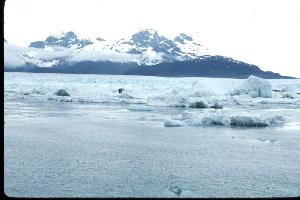 Columbia Glacier, in Prince William Sound, has retreated nine miles over the past 20 years in a meltdown punctuated by ice quakes and submarine gushes of water triple the flow of the Mississippi River.
Columbia Glacier, in Prince William Sound, has retreated nine miles over the past 20 years in a meltdown punctuated by ice quakes and submarine gushes of water triple the flow of the Mississippi River."It's 50,000 cubic meters per second ... for seven minutes," said glaciologist Tad Pfeffer early this month from the American Geophysical Union meeting in San Francisco.
"It comes out of the bottom of the glacier, and it flows up the front of the ice cliff and spreads out on the surface."
Columbia Glacier has now pulled back to the halfway point of its expected retreat. But it may be on the cusp of a much faster withdrawal across a broad inner bay, Pfeffer reported.
Scientists expect the glacier to retreat another nine or 10 miles over the next 15 to 20 years, creating a deep-water fjord with new shorelines and as-yet unseen geographic features.
The balance between the glacier's forward motion and the rate that icebergs calve has kept the glacier's face in that area. But that may be about to change, Pfeffer said.
As the glacier slowly pulls north into deeper water, the shoreline will peel away, exposing a longer face of ice to the ocean. At the same time, the glacier is up to 1,300 feet thinner in places.
Mississippi-size flushing from beneath, thinner ice on top, more exposure to the sea -- it adds up, Pfeffer said.
"All those things together reinforce my belief that this thing is going to retreat faster, certainly faster than it has in the last five years," Pfeffer said. "Maybe it's going to retreat faster than it has ever before."